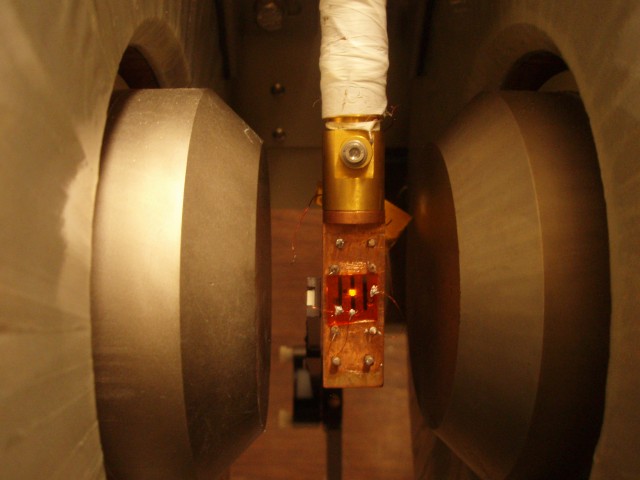
Researchers have built the first organic LED (OLED) that is controlled by the spin of the charge carriers running through the device, paving the way for future OLED devices to offer increased brightness. Though rumors say Samsung will release a 55-inch OLED TV this fall, don’t expect a spin-OLED on the market soon. This prototype orange OLED only works at temperatures below -33°Celsius (-28°Fahrenheit).
OLEDs contain layers of organic polymers sandwiched between two electrodes. (Organic here refers to molecules containing mostly carbon, hydrogen, oxygen, and nitrogen, like those in our bodies.) These polymers act like semiconductors, so applying voltage across the sandwich generates electrons at one electrode, and their positive partners, called “holes,” at the other. These electrons and holes travel along the polymers, smashing together when they meet. This collision pumps energy into the molecule. It loses that extra energy by emitting light.
But there’s a catch. Polymers only emit light when the spins of the electrons and holes are arranged in particular combinations. Think of spin as a tiny bar magnet inside the electrons and holes. When two spins meet, the north poles of each spin can point the same direction, or they can oppose each other. Both of these combinations can create light, though whether or not they both do it in the same organic semiconductor depends on the individual polymers.
In an OLED that emits light when the electron and hole spins are antiparallel, only one in three combinations creates light. Z. Valy Vardeny (at the University of Utah) and his colleagues wanted to boost the efficiency of an OLED by controlling the spin of electrons and holes as they’re pumped into the polymer. They increased the number of carriers with the proper orientation to emit light as they combine. This naturally boosts the brightness of the OLED, Vardeny says.
The scientists do this using a device called a spin valve, which was first developed to control current in 2004. This spin valve sandwiches an orange light-emitting organic polymer between two ferromagnetic electrodes. One electrode, a strip of cobalt covered with lithium fluoride, injects electrons into the polymer. The other, lanthanum strontium manganese oxide (LSMO), reliably injects spin-aligned holes. The scientists control the spin alignments of the two electrodes—and thus the spins of the charge carriers coming from those electrodes—using an external magnetic field.
To slow spins from flipping as the carriers moved along the organic semiconductor, the researchers replaced all the hydrogen atoms in the polymer with deuterium (an isotope of hydrogen that has one extra neutron). And when they applied about 3.5 V and an external magnetic field to the 300-micrometer square device, the OLED glowed orange.
Until now, spin valves have only been used control current flow because they could only inject holes, and not electrons, into a polymer. Coating the cobalt electrode with lithium fluoride turns that electrode into an electron source. Since the other electrode pumps out holes, the scientists can create the two carriers that combine to generate light.
With the right polymer, it might be possible to control the color of a spin-OLED using a magnetic field, Vardeny says. Currently, the different colors of an OLED are due to different polymers. Or perhaps one day an entire spin-OLED—including the ferromagnets—could be made of organic molecules, he adds.
Science, 2012. DOI: 10.1126/science.1223444 (About DOIs).
reader comments
17